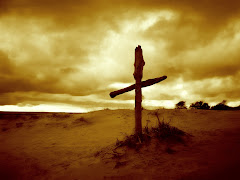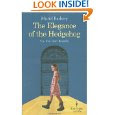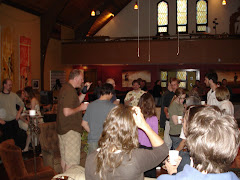It’s Advent, the season of carols, tinsel, gift-wrapping, and arguments over where the community crèche can be displayed. It’s the season that those bozos who work for Hallmark once again over-romanticize the first Christmas to such an extent that we've all actually come to believe that it really was a peaceful, starry, silent night when Jesus was born.
And because of this perennially slick advertising job, we come to the Christmas narratives in the Bible, thinking that characters within it were just blank slates. A perfect example of what I’m talking about can be found in Luke 2, the famous “shepherds abiding in the fields” passage made famous by Linus. The text says that when the angel of the Lord appeared to them, “they were filled with fear.” (The King James renders it “sore afraid.”) What were they "sore afraid" of? We assume that it had to be the angel, right? After all, on such a peaceful, clear, starry night, what else could have put fear into their hearts?
Well, given that this was 1st century Palestine we’re talking about, there are all kinds of things that could have made them afraid that night. For starters, their entire nation was being occupied and oppressed by a hostile power. The Romans weren’t just hanging out or stargazing; they were taxing the living crap out of the Jews. There were taxes on everything, including sheep, resulting in financial ruin for many a merchant in Israel. If those certain poor shepherds weren’t fearful over their finances that night, perhaps they were a little concerned for their wives, since the Roman soldiers were known to satisfy themselves with Jewish women, often in front of their husbands. Or maybe the shepherds were afraid of being beaten or beheaded for sport, fairly common occurrences in occupied Israel, occurrences that today might be called acts of terrorism.
The point is the first Christmas wasn’t all that 'Hallmarky,' to use a Palin-esque term. And so, in 2008, this year, more than ever, we who read and celebrate the Gospel accounts of Christ’s birth need to remember the state of affairs into which Jesus was born: financial peril, wars and rumors of wars, violence at home and violence abroad, terror on every side. Those shepherds abiding in their fields didn’t need some angel to make them feel afraid; they were already sore afraid. In fact, I believe that when that angel spoke her first words, “Be not afraid,” he/she was addressing the constant condition of any 1st century Palestinian’s heart. That angel, and ultimately the baby whose birth he/she announced, was entering into the very center of that fear, into the open wound that was 1st century Palestine, with all its terror, insecurity, and financial ruin.
So let’s not let Hallmark or even the TV ad whizzes gild over the conditions into which Christ was born. His world was an awful lot like our world. The fears of the 1st century Jews were an awful lot like our fears. And, therefore, the peace that this unlikely Prince offered them in the midst of all their fear is profoundly appropriate as He offers it unto us in the midst of all ours. And that, my friends, is GOOD news, very Good News.
Wednesday
Subscribe to:
Post Comments (Atom)
Eloise Anna Jones

A Reader at 8 months!
papa and Weezie

it doesn't get any better than this!


















2 comments:
The wonderful thing about providing historical context for stories in the Bible-- particularly stories like the birth of Christ-- is that it offers a context in which the emotion and hope behind the story is grounded in a way that does not require it to be an actual event-- the truth behind the words shines through in a whole different light.
I think the idea of celebrating advent without that hallmark, generic blank-slate is crucial to reaping the true joy of the season. However, I do think things like a family creche that becomes part of the ritual of advent can be a very positive part of celebrating the birth of Christ, and the overall thematic story of the journey from darkness into light.
By understanding the cultural and historical setting that each character in the Christmas story belongs to, we get a deeper understanding, and we also get the gift of the story resonating with our world today in a whole new not-cheesy Christian light. And yet, there is something about the innocence of a newborn babe, something about the blank slate moments we all feel in the awe and ever-so-simple presence of a just-born child that is central to this season too. Instead of focusing on the dark and twisty lives of fear that the shepherds were likely living, it may be enough to know that there was plenty of in-the-flesh dangers, and that the sight of an angel may have been a welcome distraction (in that do-we-have-it-so-bad-we've-become-delusional/oh-fine-everything-else-is-awful-God-might-as-well-smite-us-too kind of way).
It only takes one advent evening with a child, who lights a candle with eyes full of wonder, and week-by-week places another handmade figure into the manager to see that there is a magic, a mystery, and a sense of freedom that comes with the ritual of telling a beautiful story and simply sitting with its message of renewal and hope and life.
Can we have the mindfulness of the season both ways?
It is nice to think in this world, Christmas could fill us with the same strange wonder and sense of hope that those shepards might have felt staring at a baby in a manger. You've got a great message that you are spreading here... Merry, Merry Christmas.
Post a Comment